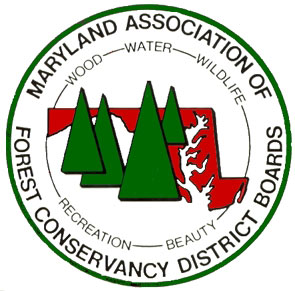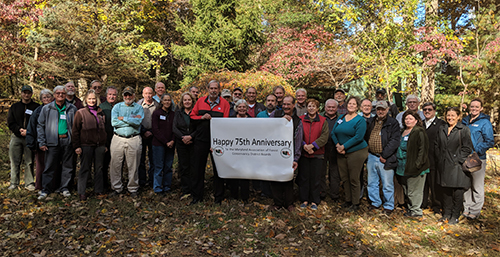For additional information regarding Forestry Board activities please contact the appropriate county Chairs from the
 Maryland Forestry Boards: Contact Information.
Maryland Forestry Boards: Contact Information.
Maryland's Open Meetings Act
In accordance with
Maryland's Open Meetings Act, Forest Conservancy District Boards meeting minutes can be found on
this webpage.
 Maryland's advocates for trees and forests since 1943
Maryland's advocates for trees and forests since 1943
Maryland’s 2.6 million acres of forest land serve the needs of many. Our forests improve water and air quality, provide wood, wildlife food and shelter, recreational opportunities and beauty. As demands on our forests increase, people pressures threaten our woodlands. Maryland is fortunate to have a network of individuals who serve voluntarily on Forestry Boards as advocates for our forests with an eye to the future.
Organization
Commonly referred to as Forestry Boards, the Forest Conservancy District Boards function in all jurisdictions— 23 Maryland Counties and Baltimore City. The 24 boards are joined in a State Association of Forest Conservancy District Boards. The Maryland Association provides a means of communication and exchange of ideas among the local boards and acts as a channel to its parent agency, the Maryland Department of Natural Resources-Forest Service (MDNR).
Purpose
The Forestry Boards were established in 1943 to assist the State’s Forest Park and Wildlife Service with the promotion of rural forest management on privately owned woodlands. Their original goal was to help assure a supply of wood fiber products through scientific forest management. Today, the role of the Forestry Boards has been expanded to help:
- Restore the Chesapeake Bay,
- Improve the environment in urban and suburban areas.
- Educate the general public about the wide range of forest benefits.

Forestry Board members celebrated 75 years of advocating for
Maryland's trees and forests at their Fall 2018 annual meeting.
Board members work closely with their project foresters and primarily serve as advisory, educational, and facilitating bodies. Under the law, the Boards are required to review and pass on all timber harvest plans in the Chesapeake Bay Critical Area and approve all such plans in their counties if requested. They may also be called upon to play a role in the management of forest properties subject to easements acquired by local jurisdictions under the Forest Conservation Act. The State Association in concert with the boards previews proposed legislation and represents the interests of forestry with local, state, and federal Legislatures.
Mission
To promote the stewardship, conservation, and sustainable use of Maryland’s Forest Resources
Forestry Board Membership
On average, there are around 250 Forestry Board volunteers appointed by the Director of Maryland Forest Service on the recommendation of the members of the Board and the local forester. The requirements for membership are an interest in sustainable forestry and a desire to see our renewable natural resource wisely used and managed. Local leaders, planners, commissioners, tree farmers, forest product workers, arborists, educators, farmers, forest consultants, loggers, forest landowners, and government representatives are but a few of the interest groups represented on the Boards.
Objectives
The Maryland Forestry Board Association established these objectives of volunteer service:
- Promote the stewardship, conservation and sustainable use of Maryland’s renewable forest resources, in urban, suburban, and rural areas.
- Assist the Boards and the Forest Service in the preparation and dissemination of educational material on the value of trees, forests for the Bay, Stewardship and Sustainable Forest Management Plans for small and large landowners, health of our forest, etc. through seminars and other means of communication to students, teachers, decision makers, land-owners, and general public.
- Serve as an advisory and advocacy board for the Forest Service.
- Promote cooperation with other forestry related organizations and to further mutually agreed upon objectives.
- Raise and distribute funds for scholarships, educational material, programs and board activities.
Programs
The Maryland Forestry Board Association primarily works through the following committees:
Public Education. Forestry Boards work to increase public awareness of environmental concerns, good sustainable forestry practices and the many benefits of tree cover in rural, urban, suburban and Chesapeake Bay areas. Efforts include Arbor Day ceremonies, school programs such as Schoolyard Reforestation Wildlife Habitat, off-campus reforestation/buffer plantings, and Project Learning Tree - a hands-on learning experience. Boards organize adult programs such as urban/suburban street tree planting, seminars on invasive species, insect and disease control, best management practices, stewardship plans, and sustainable forest management plans. They also provide communications for newspapers, radio, TV and websites.
